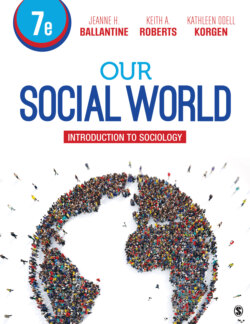Читать книгу Our Social World - Kathleen Odell Korgen - Страница 57
На сайте Литреса книга снята с продажи.
The Social World Model and This Book
ОглавлениеThe social world engulfs each of us from the moment of our birth until we die. Throughout our lives, each of us is part of a set of social relationships that provides guidelines for how we interact with others and how we see ourselves. This does not mean that human behavior is strictly determined by our links to the social world. Humans are more than mere puppets whose behavior is programmed by social structure. It does mean, however, that the individual and the larger social world influence each other. We are influenced by, and we have influence on, our social environment. The social world is a human creation, and we can and do change that which we create. It influences our behaviors, and we influence our social world. In this sense, social units are constantly emerging and changing in the course of human action and interaction.
The difficulty for most of us is that we are so caught up in our daily concerns that we fail to see and understand the social forces at work in our personal lives. What we need are conceptual and methodological tools to help us gain a more complete and accurate perspective on the social world. The ideas, theories, methods, and levels of analysis employed by sociologists are the very tools that will help give us that perspective. To use an analogy, each different lens of a camera gives the photographer a unique view of the world. Wide-angle lenses, close-up lenses, telephoto lenses, and special filters each serve a purpose in creating a distinctive picture or frame of the world. No one lens provides the complete picture. Yet the combination of images produced by various lenses allows us to examine in detail aspects of the world we might ordinarily overlook. That is what the sociological perspective gives us: a unique set of lenses to see the social world around us with deeper understanding. In seeing the social world from a sociological perspective, we are better able to understand who we are as social beings.
Throughout this book, we use the social world model as the framework for understanding the social units, processes, and surrounding environment. We look at each social unit and process. We take the unit out, examine it, and then return it to its place in the interconnected social world model so that you can comprehend the whole social world and its parts, like putting a puzzle together. Look for the model at the beginning of every chapter. We also explain the micro-, meso-, and macro-level dimensions of issues throughout the text. Test your understanding of these concepts by identifying the levels of analysis in the following Engaging Sociology.
Engaging Sociology
Micro-Meso-Macro: An Application Exercise
Imagine there has been a major economic downturn (recession) in your local community. Identify three possible events at each level (micro, meso, and macro) that might contribute to the economic troubles in your town.
The micro (local community) level:
1 _________________________________________________
2 ________________________________________________
3 ________________________________________________
The meso (intermediate—state, organizational, or ethnic subculture) level:
1 ________________________________________________
2 ________________________________________________
3 ________________________________________________
The macro (national/global) level:
1 ________________________________________________
2 ________________________________________________
3 ________________________________________________
Our next chapter asks the following: When we say we know something about society, how is it that we know? What is considered evidence in sociology, and what lens (theory) do we use to interpret the data? We now turn to how we gather data to help us develop hypotheses, test theories, and understand the social world.
